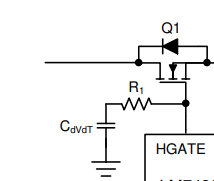Hi Team,
A customer is using this device as a highside NMOS switch.
However, the high side output does not turn on the NMOS. The voltage on OVP, UVLO, EN and are all ok but the nPGND and Timer is around 5.5V.
They tried to increase TIMER caps to 1uF but it does not help. When the TIMER pin is connected to GND the NMOS turns on when no load but when connecting high capacitive load output had not rise above 3.5V.

I hope you can check. Thank you for the help.
Regards,
Marvin



